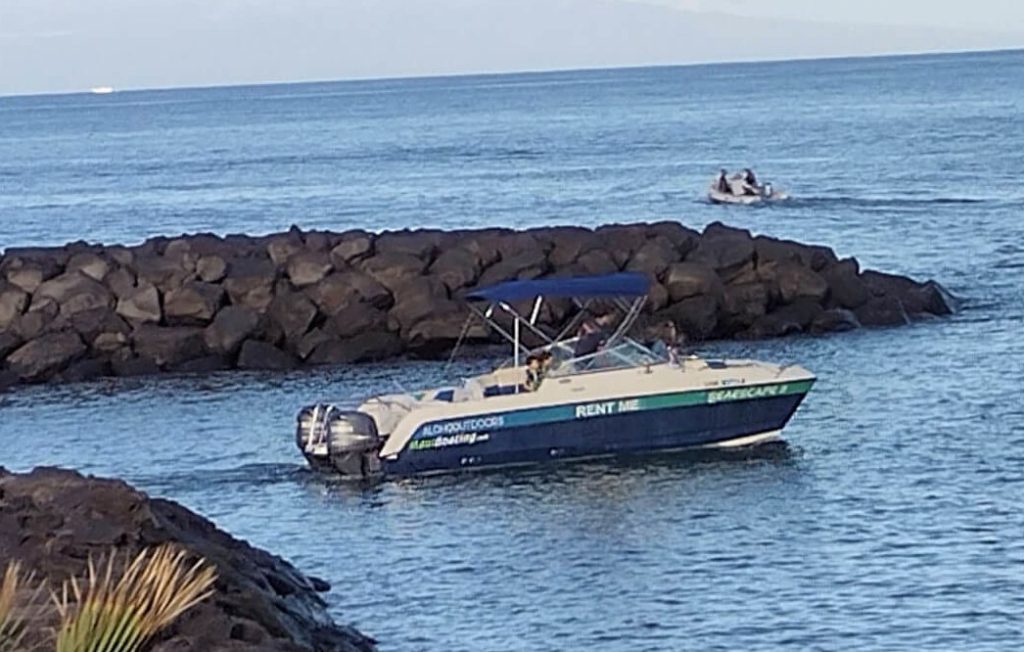
The Glacier Bay 2240sx Renegade is a HUGE 22-foot bow rider with a catamaran hull that offers safety and versatility for fishing in open waters or cruising in comfort with a group of friends or family. This catamaran is a very different animal than the Lagoon 380 we recently reviewed, but they both share a roomy layout and twin-engine performance. Is the Glacier Bay 2240 SX Renegade a rental boat worthy of the Busy Boater seal of approval? We rented one on the lee shore of Maui from Aloha Outdoors to find out.
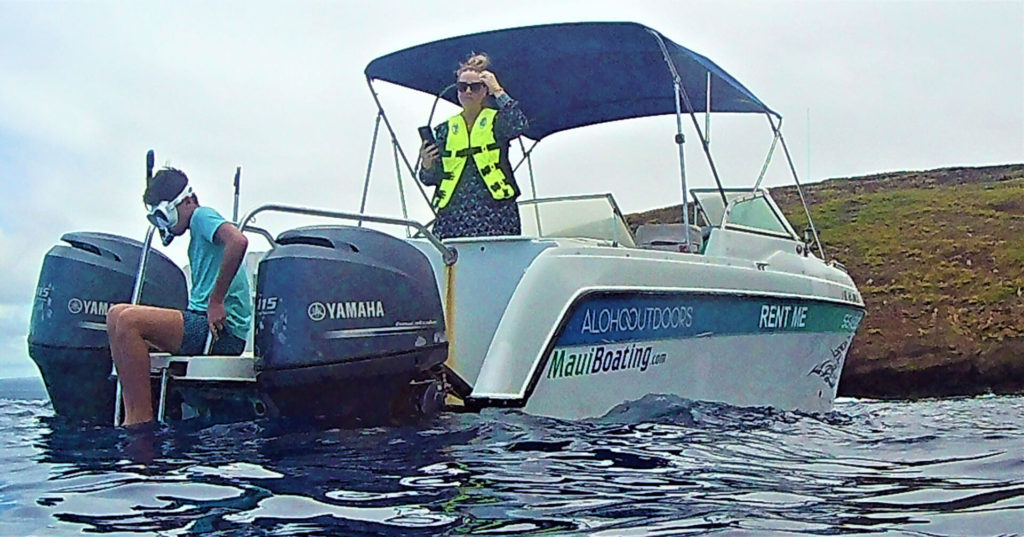
Highs
- Smooth, quiet ride
- Plenty of power and speed to get you there fast and muscle your way through rough conditions
- Twin engines offer redundancy and maneuverability
- Incredibly roomy
Lows
- Capacity rating of eight passengers is low for this size of boat
- No forward-facing seat at windshield for lookout
- Side to side rolling motion contributes to sea sickness
Piloting the Glacier Bay 2240sx Renegade
Glacier Bay 2240 Engines
Our test boat was equipped with twin 115hp fuel injected Yamaha outboard engines with close to 3,000 hours on them. Many would consider this a very high number of hours, especially in a salt-water rental fleet. However, these engines shifted smoothly, started easily, and cruised cleanly and quietly. I consider this a testament to Yamaha, which is an expensive engine option, as well as the strong maintenance program the rental company must be managing.
It is important to have an engine that starts, idles and shifts confidently when you are docking. A stalled engine just as you need to reverse to stop the boat can result in bruised fiberglass and a bruised ego. Fuel injection has helped exponentially in this area. Higher end outboards, like this Yamaha, tend to have a more compliant shift whereas entry level Mercury units grind when shifting in and out of neutral. I’ve been told many times that this is normal and acceptable, but it does not inspire confidence.
The twin engine configuration also inspires confidence with redundancy. Each engine has a separate 75 gallon fuel tanks and its own electrical system. This isolation ensures that mechanical failure, whether it be related to fuel, battery, or the motor, is isolated to one side of the boat. The engines are close enough to the centerline that the boat is fully capable of running under one engine in the event of a failure.
At the Helm of the 2240
The helm was well positioned and comfortable for all three Busy Boaters, ranging from 5 feet to 6 feet tall. All of the instruments were easy to see without obstructing the view of the water ahead. The stereo was exposed to the sun and very difficult to read, requiring me to lean in and cover it with my hand to confirm settings. Luckily we didn’t need to view it much since we could set the music on our phone with the Bluetooth. I’ll also note that our test boat, equipped with four 6.5″ speakers and a budget marine head unit was more than adequate at filling the boat with tunes under way.
The twin throttles located to the right of the wheel were very easy to see and operate from the helm seat. All of the electrical switches were also visible and easy to access, just below the throttles. The VHF was mounted below the wheel, but we could hear it fine from there and it was easy to adjust volume and squelch knobs in that location.
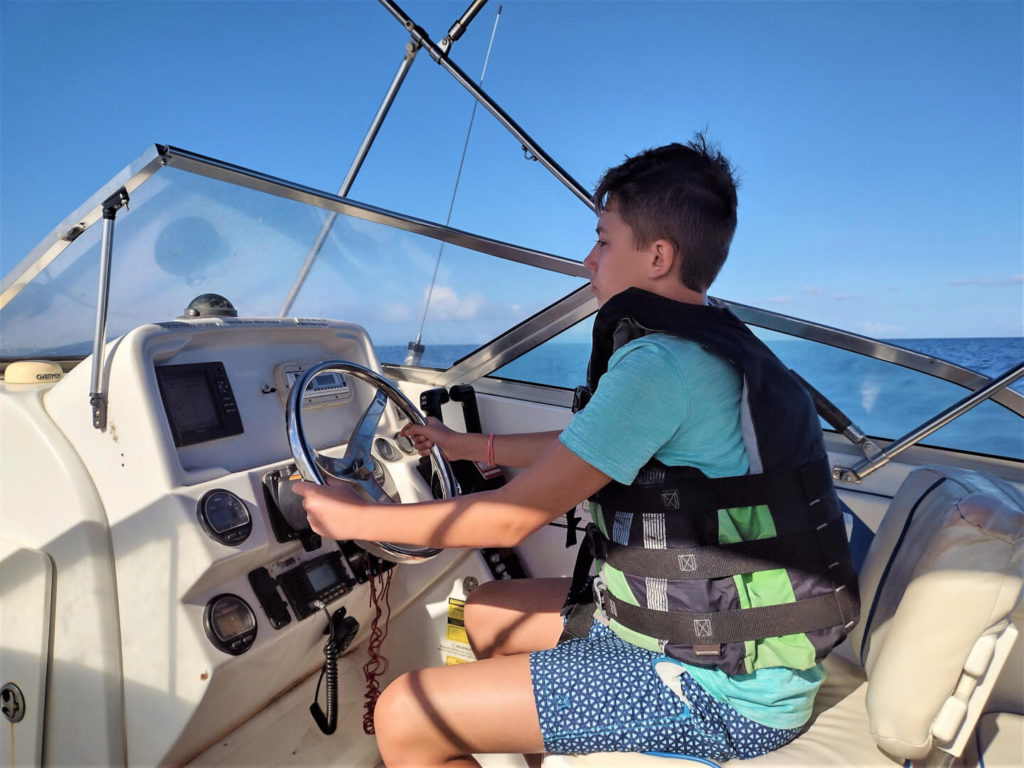
The ladder back helm seat was surprisingly comfortable. It looks less comfy than some of the swoopy bucket seats you often see in bowriders. However, the padding was adequate and the armrest was a welcome addition that made it easier to position yourself without being able to move the chair from its fixed post. We were also able to get a bit more height on the seat by sitting on the throwable life preserver.
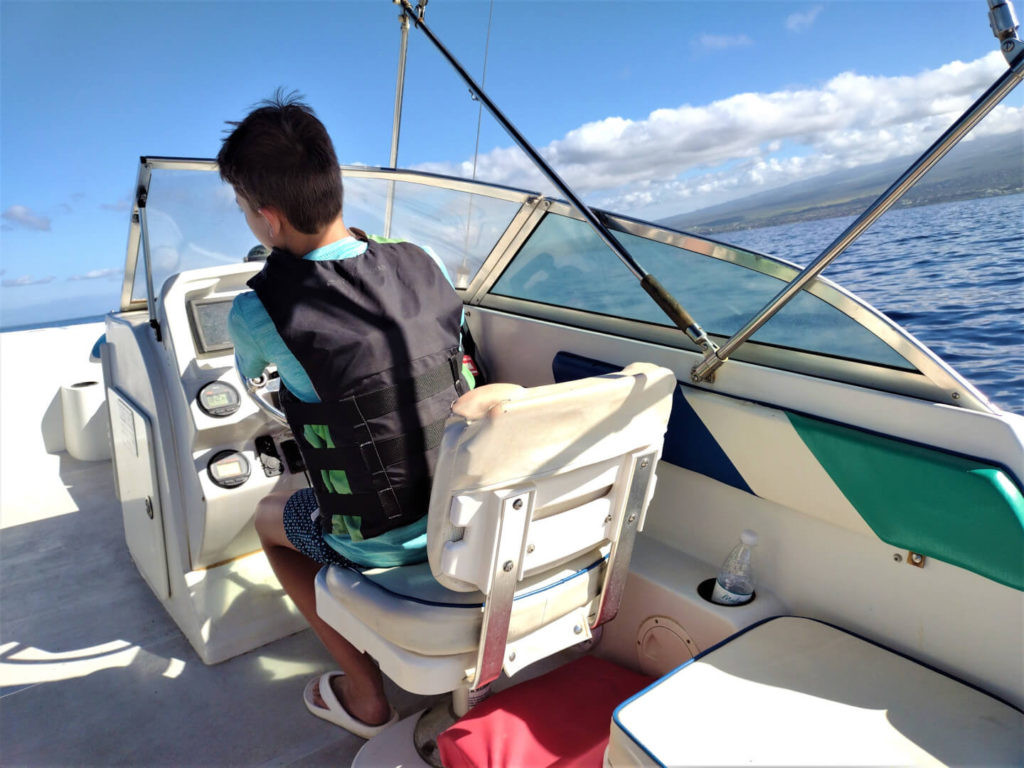
The boat did not have a rudder indicator, water speed indicator, or depth sounder. This lack of instruments was not a show-stopper on this boat. It was easy to determine the wheel position by looking behind the helm to see the direction the outboards were pointed. The boat was equipped with a GPS chart plotter that indicated the charted water depth as well as GPS speed. Additionally, the shoreline drops off quickly where we were in Maui. So there wasn’t a lot of concern over water depth.
The boat was not equipped with hydraulic steering. While the steering wheel still turned with little effort, it took quite a few turns of the wheel to turn the motors from lock to lock. However, the wheel did have a spinner knob to make it easier to quickly make a hard turn. The twin engines also make tight turns easier because you can throttle up one engine with the other in neutral, or even put one in forward and one in reverse to rotate the boat in place.
Under Way in the Catamaran
The boat cruised nicely with the engines at 3,900 RPMs, making about 19 knots. At this speed in swells of 1-2 feet, the boat got some lift over the waves, but came down very softly without ever crashing. This was true when we were running into the waves, with the waves, or quartered to the waves (waves coming at a 45-degree angle to the bow or stern). It was a very remarkable ride that allowed me to sit back and relax whereas in so many monohull boats, I would have been watching the bow and the waves and throttling up and down to keep from crashing over a poorly timed wave. My only complaint here is taking the waves from the side caused an exaggerated side to side rolling motion. Though this was less of an issue at higher speeds than at idle.
Cruising at 3,900 rpms, the boat was incredibly quiet at the helm, with more noise coming from the water than the twin engines. In addition to being Yamahas (known for quiet performance) the outboards were mounted below the boat’s tall transom, which helped to block sound from entering the boat. I don’t like to explore the limits of an unfamiliar boat in unfamiliar water, but this boat can probably break 30 knots given the motors are rated to run around 6,000 RPMs at wide open throttle.
We spent quite a bit of time running at slower speeds as well:
- The boat idled at 800 RPMs and 3 knots.
- When cruising along the coastline looking for whales, or eating lunch, we ran the boat at 1,000 RPMs and 5 knots.
- We also found a very comfortable speed around 3,000 RPMs and 12 knots that was fast enough to smooth out the ride but slow enough to settle the lift over waves. I suspect this is a relatively inefficient way to travel given that the bow was riding a bit high and 3,900 RPMs offered 60% more speed for 30% more RPMs. However, the ride was much more compliant than a traditional monohull running below its planing speed.
- Note that the boat planed very easily, and the bow rise was never an impediment to visibility.
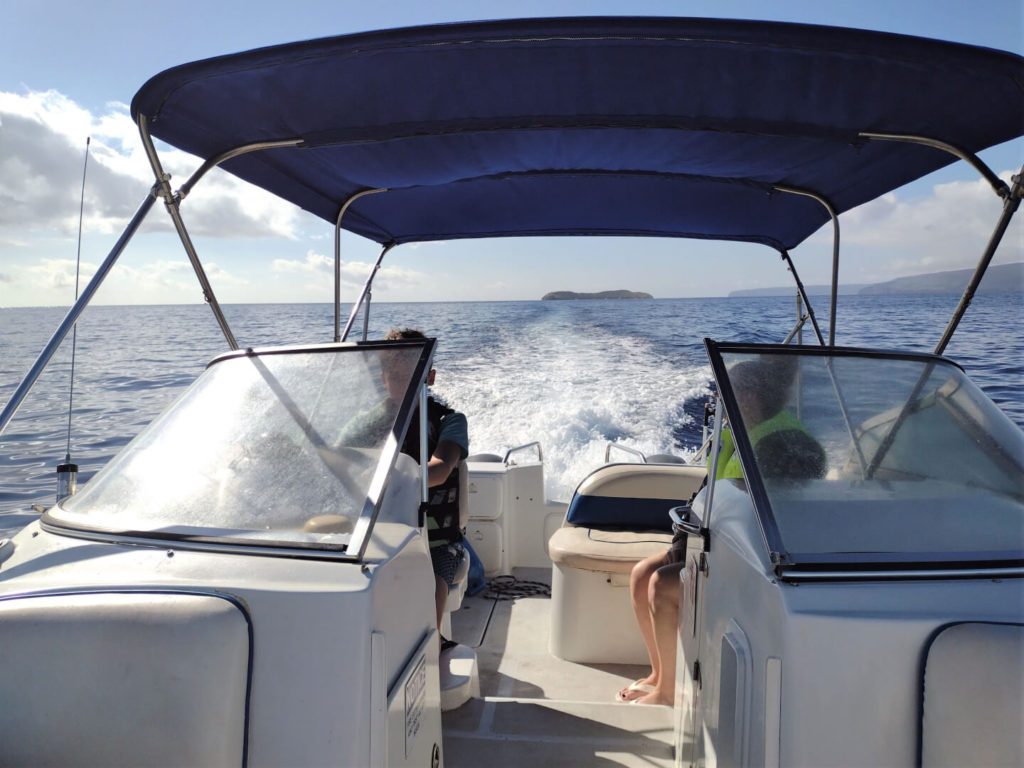
Glacier Bay 2240sx Storage
An abundance of cupholders is always handy on a boat. They can be used to secure sunglasses, keys, cell phones and other small items, in addition to beverages, which themselves are important on a sunny day to keep the crew hydrated. This boat was equipped with ten cup holders:
- One at each end of the two benches in the bow
- Two at each end of the lounge seat (two of them accessible from the fishing cockpit).
- One just to the right of the helm seat and one behind the helm seat that can be accessed from the helm or the live well seat.
While some of the cupholders were mounted precariously high, the two forward cupholders in the bow and the two at the helm were down low, allowing for relatively secure storage.
The dash area below the windshield also offered a convenient place to secure charts, binoculars, phones and the like without obstructing the forward view.
There were three spacious storage compartments throughout the boat:
- A set of double doors in the cockpit allow easy access to the long wide storage area under the lounge seat.
- A large hatch slides open between the lounge seat and the windshield to reveal a tall, deep compartment with standing room. This can be used for changing into a swimsuit or going potty (if you brought a bucket or cassette toilet). It also runs the full length of the port (left) bench seat in the bow. Fishing poles and other large items can be stored here. This is more secure than many boats that only have room for poles under the gunwales in the cockpit.
- The starboard (right) bench seat in the bow lifts to reveal storage that runs back underneath the helm. On our boat, life jackets were stored under the bench. Other safety equipment was stored under the helm where it could be accessed through a small hatch.
A live well is located behind the helm seat that doubles as an additional seat. We used it as a cooler for our lunch. It could have easily swallowed three more 12″x8″ tote bags like the one we brought.
Glacier Bay 2240sx Renegade Layout
While the boat is very roomy with ten cupholders and comfortable seating for at least that many, the capacity plate shows a limit of eight passengers. This is a surprisingly low rating for a boat this large with this much freeboard (height above the waterline). However, its intended use in rough open waters may have something to do with this. Regardless of the capacity rating, our rental company limits capacity to six passengers. In rough conditions, you’ll want to have everyone behind the windshield. More than six without the bow seating would start to be tight.
This boat has a rather unique layout, with the forward 3/4 of the length equipped like a typical side console deck boat with wide, comfortable lounge seating, and a wrap-around windshield. The final few feet of the boat has an open cockpit area for fishing. Being a catamaran, the Glacier Bay 2240 is very wide for its length, and the outboards eliminate the need for engine space within the hull. With these space improving advantages, you really get as much room as you’d expect in a typical 22-footer just in the front 3/4 of the boat. So you can look at the rear cockpit as gravy for easier fishing or additional storage.
Glacier Bay 2240 Cockpit
The open cockpit is a great spot for working your fish without seats getting in the way. It can also be used to stash a cooler, towels, or other equipment. Rod holders are integrated into each of the side rails. A cutting board is mounted on the starboard (right) stern rail. The cutting board is in a perfect spot to wipe and wash fish guts back into the water and out of the boat. It also has a hole to secure a dirty knife on the outside of the hull. This keeps your sharp bloody blade from falling overboard or making a mess inside the boat.

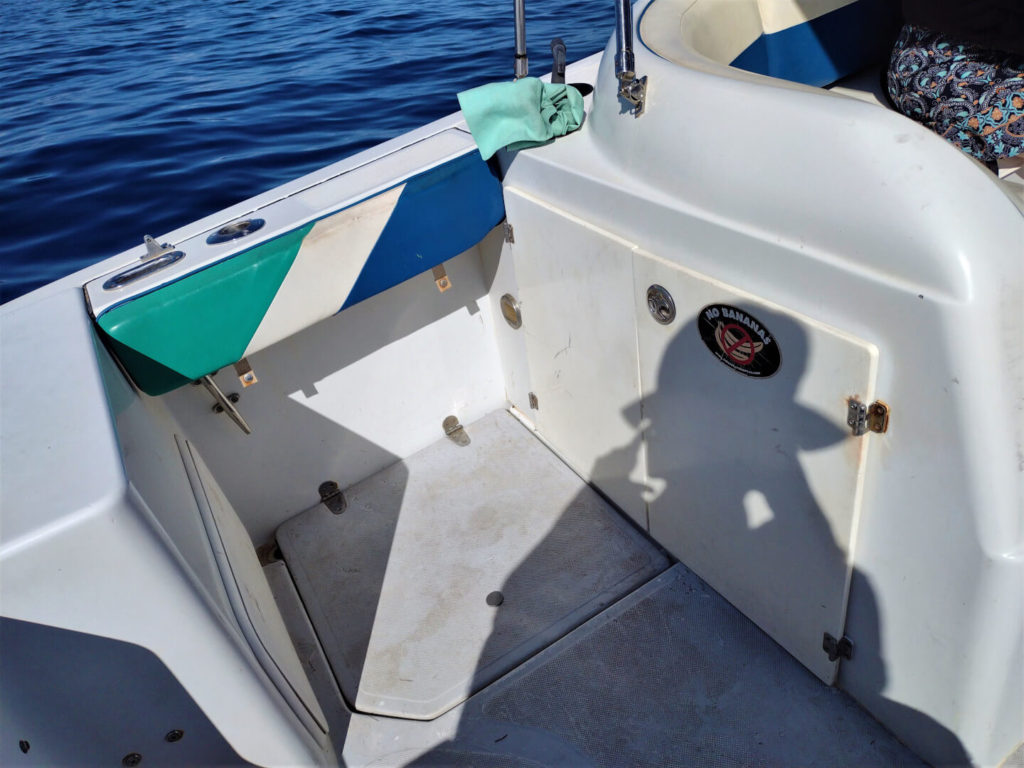
The center of the cockpit has a cutout to allow easy access to the swim platform. The swim platform has a long ladder with four rungs. Tall railings extend the full length of the platform. This allows you to easily board the boat both from the water and when it is on a trailer.
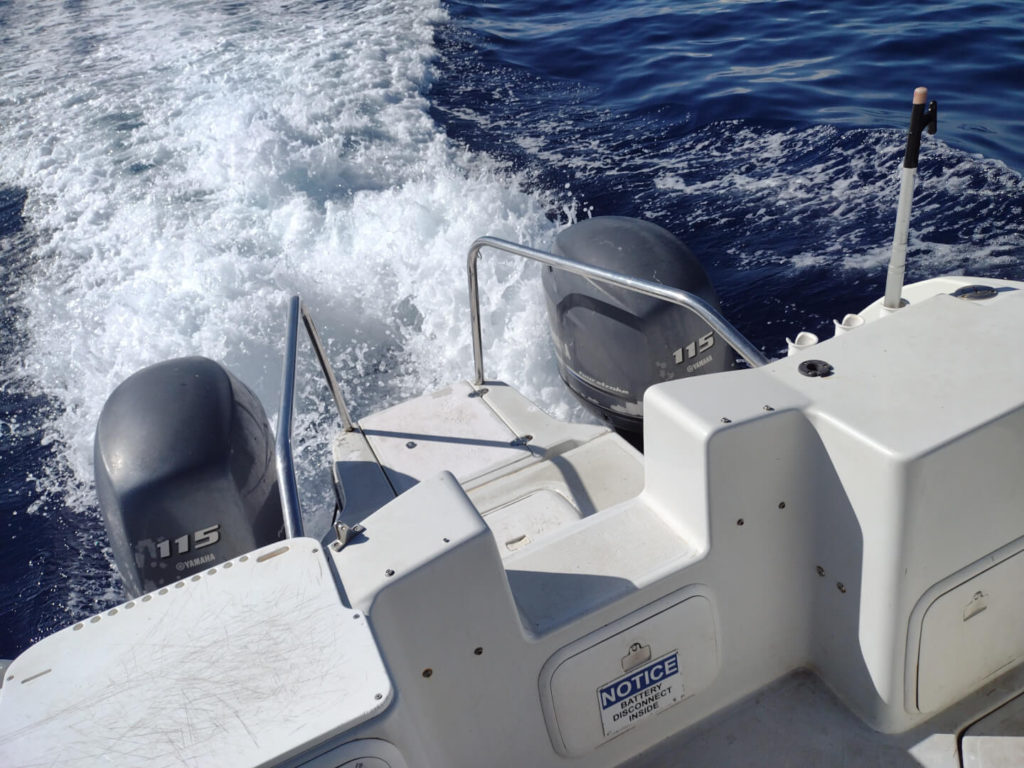
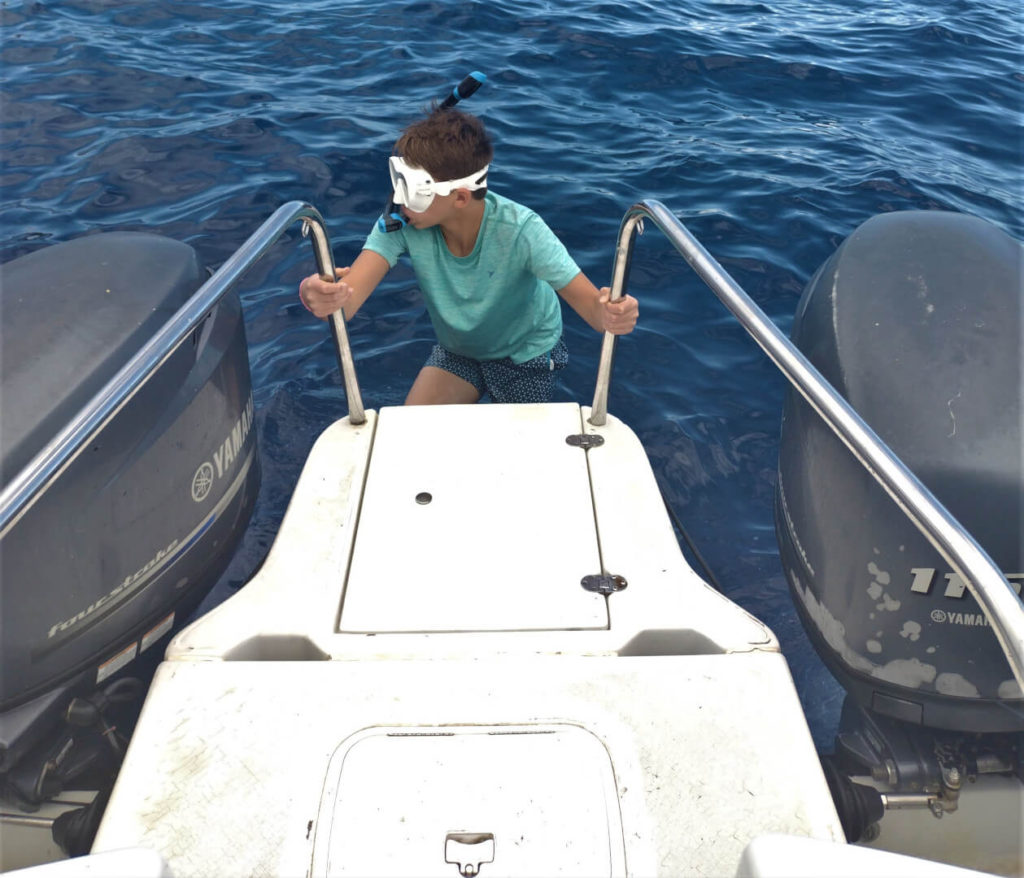
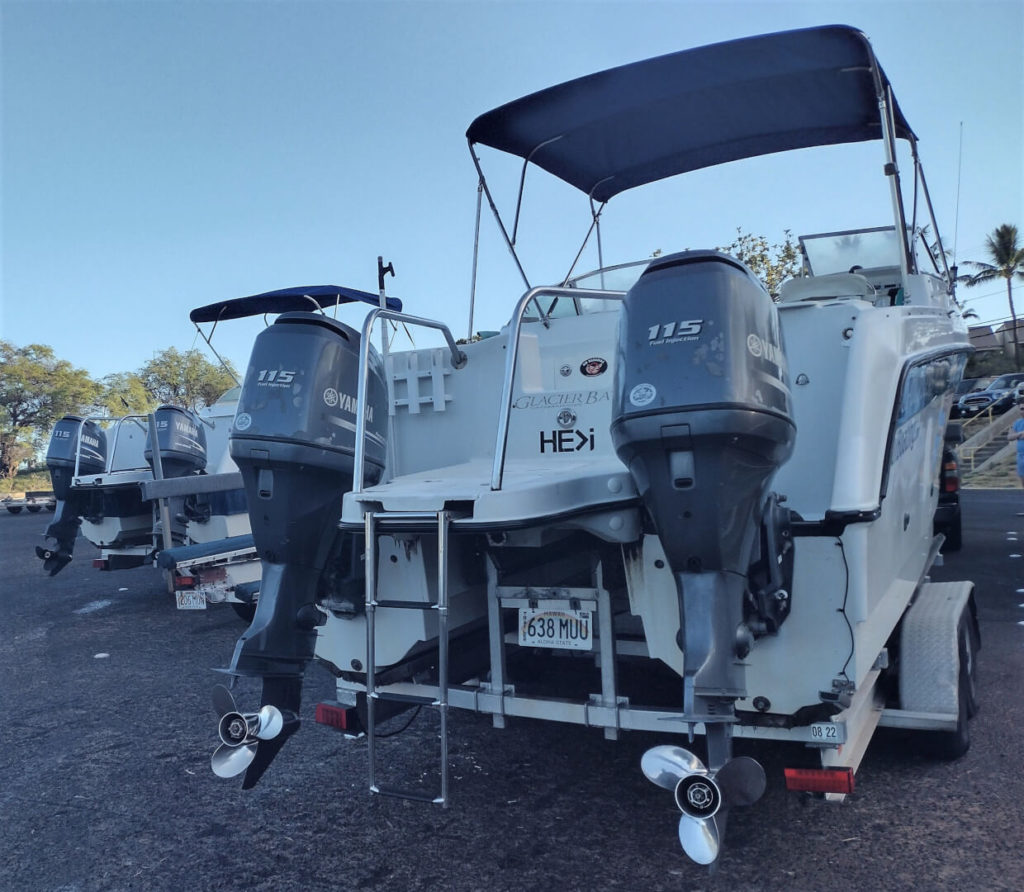
Helm and Lounge Area in the 2240 Catamaran
The center area of the boat can seat five comfortably behind the windshield. In addition to the helm seat, there is a seat on the live well behind the helm. An L shaped lounge seat large enough for three people sits opposite the helm. Personally, I prefer a front facing seat next to the helm for a lookout/navigation companion. On this boat I found myself standing behind the helm seat when Busy Boater Jr was running the boat.
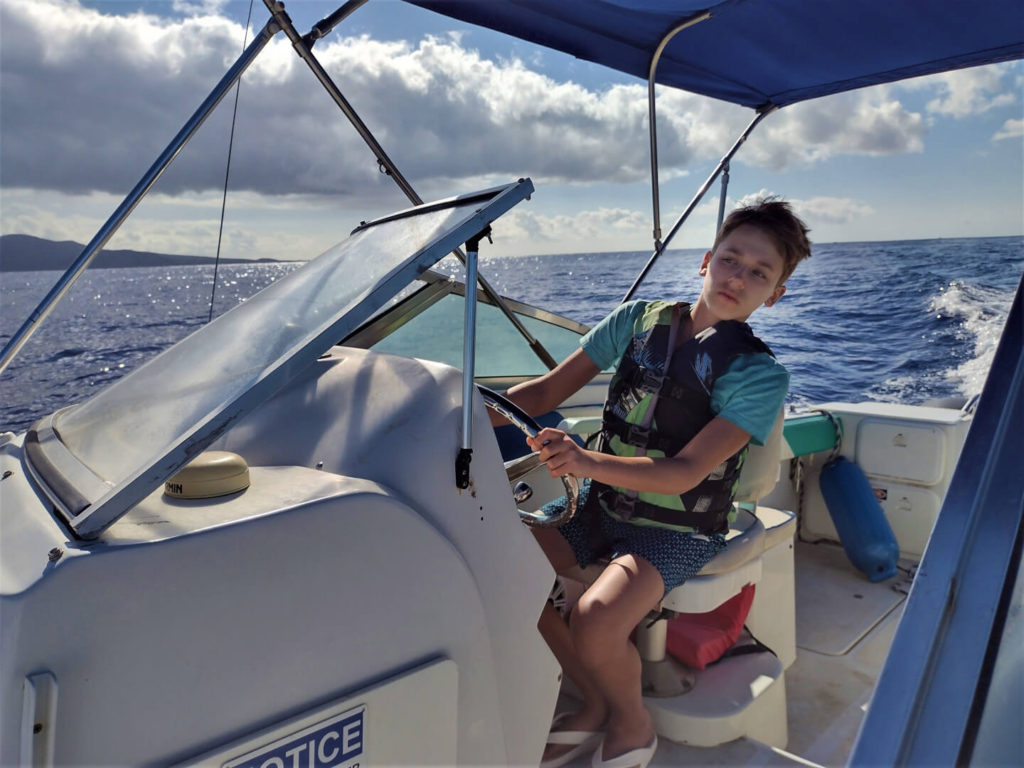

The boat had a very generous bimini top with a sturdy frame. It ran from the dash to the end of the lounge seat providing good protection from the sun. It was also quite tall, allowing me, at six feet tall, to stand up straight without hitting my head.
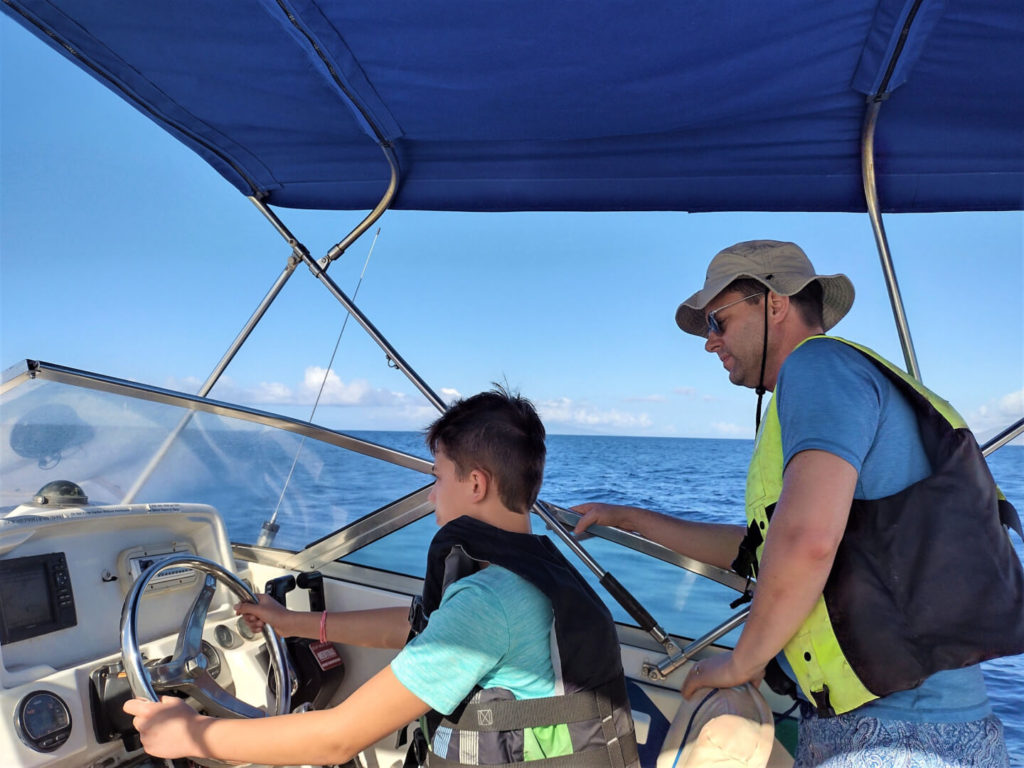
My biggest beef with the design of the Glacier Bay 2240sx Renegade was a small step that ran the width of the boat near the helm. If you don’t notice it while moving quickly through the boat, you can trip.
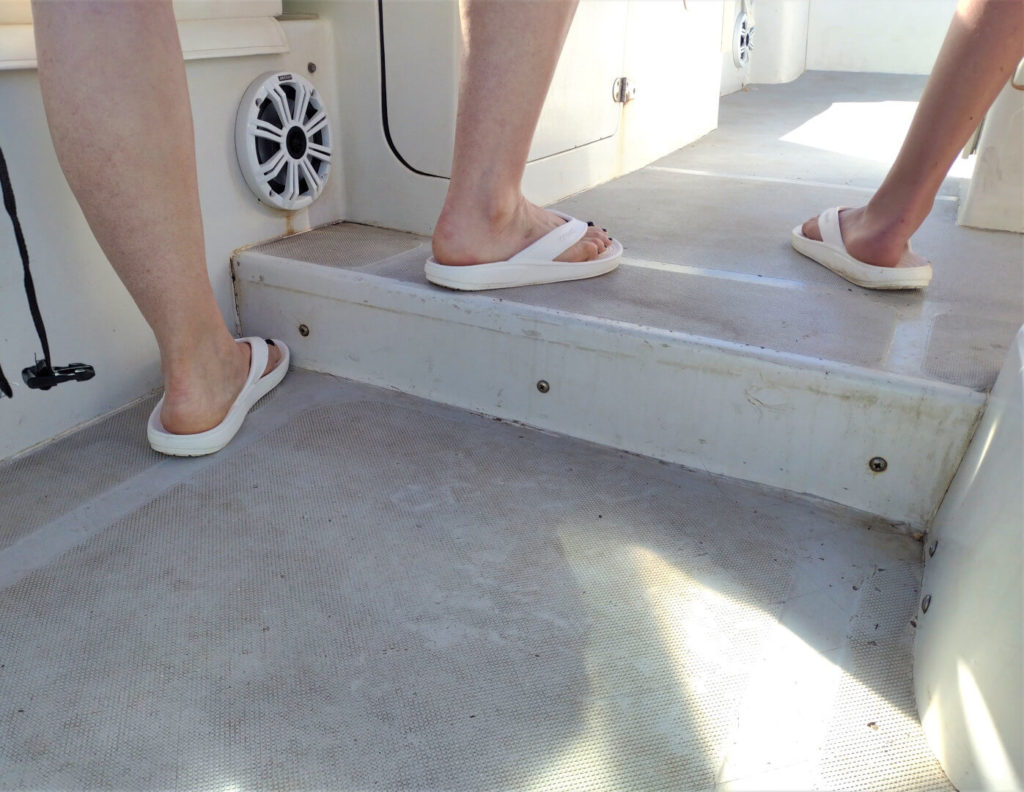
Glacier Bay 2240sx Renegade Bow
The catamaran advantage is most evident in the bow area where the boat carries its full 8.5 foot beam all the way forward. A wide bench on each side of the Glacier Bay 2240sx Renegade bow area with deep backs and heavy bow rails provides a sense of security while under way.
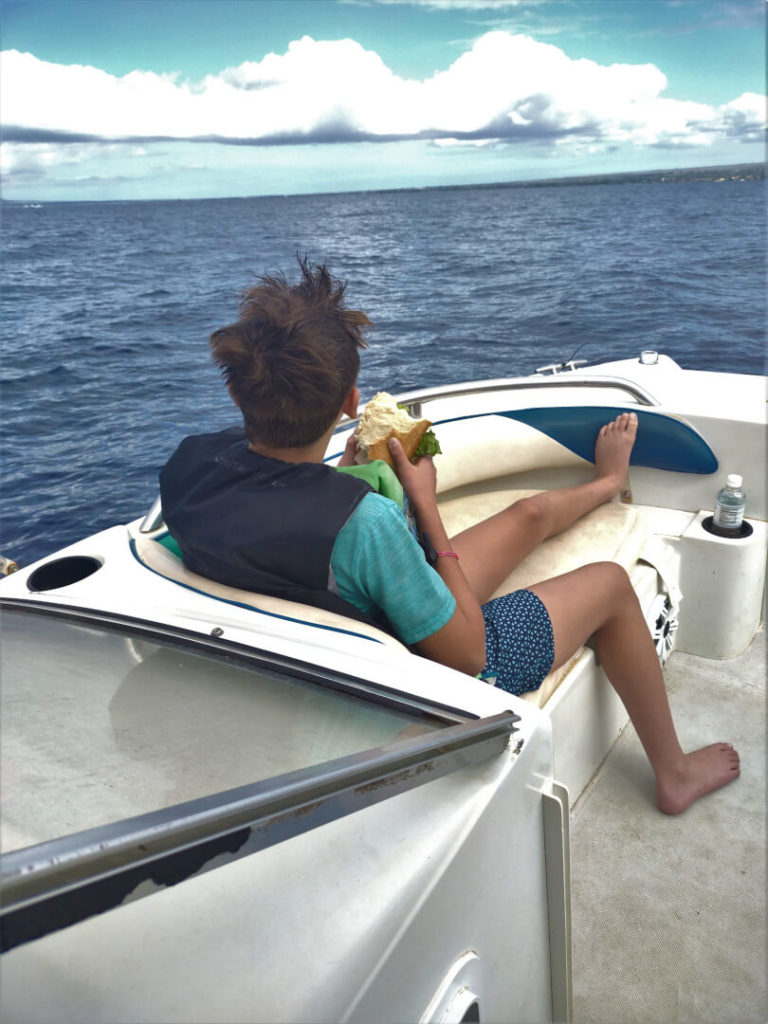

How Much Does a Glacier Bay 2240sx Renegade Cost to Rent and Where Can I Find One?
Aloha Outdoors has three Glacier Bay 2240sx Renegade’s available for rent in Maui, Hawaii from a boat ramp just North of Wailea in Kihei. As of this writing, you can rent for 5 hours for $695 or 6 hours for $795. On water instruction is available if you aren’t ready to take the boat out on your own. They normally have shorter rental options as well, but they don’t currently have enough staff to support multiple turns per day. #BlameCovid #GreatResignation
Boatsetter has a Glacier Bay 2270 listed for rent on Oahu, north of Honolulu, Hawaii. The 2270 offers the same hull with a cuddy cabin: the bow is enclosed ahead of the windshield. This design is better for rough seas as it will quickly shed water that comes over the bow, but it comes at the expense of seating. I won’t mention the price because of Boatsetter’s lack of transparency in its fee structure.
Club Nautico just South of Miami, Florida on Key Biscayne rents a 27 foot Glacier Bay for $900 4hrs/$1,300 8 hrs. It has the same great layout as the 2240, just a bit more of everything.
What Kind of Experience Do I Need to Rent a Glacier Bay 2240 Catamaran?
The Glacier Bay 2240sx Renegade itself is very easy to run. It would be reasonable for an inexperienced boater to take one out on a calm lake with help coming and going from the dock. However, this is a big water boat. You’ll need a lot of (well placed) confidence to take this boat out in the cruising grounds it was designed for. Such as the unprotected waters and high surf of Hawaii, or the incredible tidal currents and shallow waters of the Florida Keys.
Aloha Outdoors requires 100 hours of experience on a boat >20 feet with 10 hours at the helm. Preferably on the Ocean. That’s a good barometer. Although its probably most important to have experience on a powerboat smaller than 30 feet with console steering. In fact a smaller planing dinghy with console steering will give you a lot of experience handling in chop, even in a lake. However, sail boats, pontoon boats, trawlers, and tiller controlled fishing boats don’t lend the appropriate experience to take on this challenge. If you don’t have the requisite experience, taking an instructor out with you in rough waters will prep you for your next rental opportunity.
If you want to get out on the water in Maui, but aren’t ready to rent the Glacier Bay 2240, we explore a few other options in our Maui Boat Rental Article.
Similar Boats
Like many other boats, the Great Recession killed the Glacier Bay 2240sx Renegade. 2008 was the last model year for the 2240 series as Glacier Bay focused on a smaller number of larger catamarans until consolidating with Carolina Cat, World Cat, and Livingston over the following decade. The company has recently reintroduced a similar model called the World Cat 230SD.
A deck boat or pontoon boat will give you the roomy lounginess of this boat with a higher capacity rating. The tradeoff being less ability to handle rough water. This could fit the bill on a calm lake, river, or even more protected ocean passages. Examples of deck boats include Hurricane and the Bayliner Element series.
